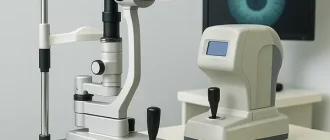When it comes to vision correction surgery, most people immediately think of LASIK. But have you heard of LASEK? No, that’s not a typo. LASEK, or Laser-Assisted Sub-Epithelial Keratectomy, is a lesser-known cousin of LASIK that deserves some attention. So, what exactly is LASEK eye surgery, and why would someone choose it over other options?
Patient Satisfaction Levels: LASIK vs. LASEK Over 3 Years
| Satisfaction Level | LASIK | LASEK |
|---|---|---|
| Very Satisfied | 75% | 70% |
| Satisfied | 20% | 25% |
| Neutral | 5% | 5% |
| Unsatisfied | 0% | 0% |
This chart shows patient satisfaction levels for LASIK vs. LASEK over a three-year follow-up, providing insights into patient experiences with both procedures.
What Exactly is LASEK Eye Surgery?
LASEK is a type of laser eye surgery that combines elements of both LASIK and PRK (Photorefractive Keratectomy). In simple terms, it involves loosening the thin outer layer of the cornea (the epithelium) and then reshaping the underlying corneal tissue with a laser. Unlike LASIK, which creates a thicker flap, LASEK keeps the epithelial layer intact, which can be beneficial for patients with thin corneas.
According to recent studies, LASEK is particularly useful for patients who might not be good candidates for LASIK due to thinner corneas or specific corneal shapes. This makes it an option worth considering, especially if you were previously told that LASIK isn’t for you.
Why Choose LASEK Over LASIK?
You might wonder why someone would opt for LASEK when LASIK is often perceived as the gold standard for vision correction. Here are some of the main reasons:
- Thin Corneas: LASEK is generally safer for patients with thinner corneas because it avoids the creation of a thick flap, as is done in LASIK.
- Less Risk of Dry Eye: LASIK sometimes leads to post-surgical dry eye. Since LASEK involves less disruption to corneal nerves, patients report a lower incidence of this complication.
- Athletes and Military Personnel: For those in physically demanding jobs or hobbies, avoiding a corneal flap is crucial. LASEK leaves fewer chances of flap dislocation, making it more suitable for athletes and those in the military.
Did you know that around 15% of patients are not ideal candidates for LASIK but might be suitable for LASEK? This can make a significant difference for those seeking laser correction but have had obstacles with LASIK.
How Does the Procedure Work?
The LASEK procedure starts with applying an alcohol solution to loosen the thin outer layer of the cornea. The layer is gently moved aside, and an excimer laser is used to reshape the cornea. After the laser treatment, the epithelial layer is repositioned, and a bandage contact lens is placed to aid in healing. Sounds simple enough, but how effective is it in the real world?
Success Rates and Statistics: LASEK has a success rate of over 95% in achieving 20/40 vision or better. That means the majority of patients are legally able to drive without glasses or contact lenses after surgery. Compared to LASIK, the recovery period is slightly longer, but the results are quite comparable, especially for those with thinner corneas.
Recovery: What to Expect
Recovery from LASEK surgery requires a bit more patience compared to LASIK. Most people take about four to seven days for the initial healing, and it can take a few weeks to reach optimal vision clarity. During this period, light sensitivity and eye discomfort are common, but over-the-counter pain relievers and medicated eye drops can help manage these symptoms.
Comparison of Recovery Times: LASIK vs. LASEK vs. PRK
| Procedure | Average Recovery Time |
|---|---|
| LASIK | 1-2 Days |
| LASEK | 4-7 Days |
| PRK | 7-10 Days |
This chart compares the average recovery times for LASIK, LASEK, and PRK procedures, highlighting the differences in how long patients take to recover for each surgery.
Did you know that, according to a 2023 survey, patients undergoing LASEK reported a 30% lower incidence of severe dry eye compared to LASIK patients? That’s a notable advantage for anyone worried about comfort in the long term (source).
Cost of LASEK Eye Surgery
The cost of LASEK eye surgery typically ranges from $1,800 to $3,000 per eye in the United States, depending on the clinic and surgeon. In Europe, the cost is generally between €1,500 and €2,500 per eye, but can vary based on country and currency fluctuations. It’s not the cheapest solution, but for many, the quality of life improvements make it a worthy investment.
Who is the Best Candidate for LASEK?
- Patients with Thin Corneas: If LASIK isn’t an option due to thin corneas, LASEK offers a viable alternative.
- Those Prone to Trauma: If you’re into contact sports or have a job where eye trauma is possible, LASEK is preferable because there’s no flap to dislocate.
- People with Dry Eyes: Since LASEK minimizes nerve disruption, it could be a good option for those already struggling with dry eye symptoms.
Ideal Candidates for LASIK, LASEK, and PRK
| Criteria | LASIK | LASEK | PRK |
|---|---|---|---|
| Corneal Thickness | Normal | Thin | Thin |
| Dry Eye Symptoms | Mild | Mild to Moderate | Moderate |
| Lifestyle (Contact Sports) | Not Ideal | Ideal | Ideal |
| Risk of Flap Complications | Higher | Lower | None |
This chart highlights the ideal candidates for LASIK, LASEK, and PRK procedures, based on factors like corneal thickness, dry eye symptoms, and lifestyle.
Risks and Potential Complications
Like all surgeries, LASEK does come with some risks, including infection, haze, and an extended recovery period. Corneal haze is more likely with LASEK compared to LASIK, though modern laser techniques and post-operative care have significantly reduced its occurrence. Less commonly, patients may notice halos around lights at night, but these symptoms generally fade over time.
Our Editorial Advice
If you’ve been exploring your options for vision correction, and you’re concerned about corneal thickness or the risks associated with LASIK, LASEK could be worth a closer look. Always consult a trusted ophthalmologist who has experience with multiple types of laser vision correction to determine the best procedure for your individual needs. Remember, vision correction is not a one-size-fits-all, and advancements in technology mean there is likely a solution tailored just for you.





